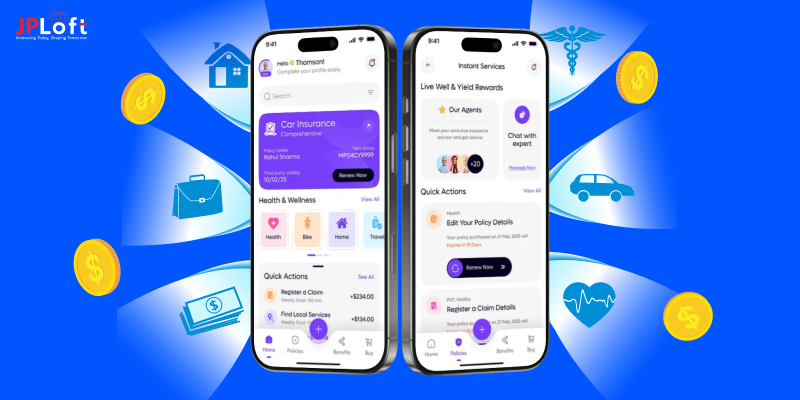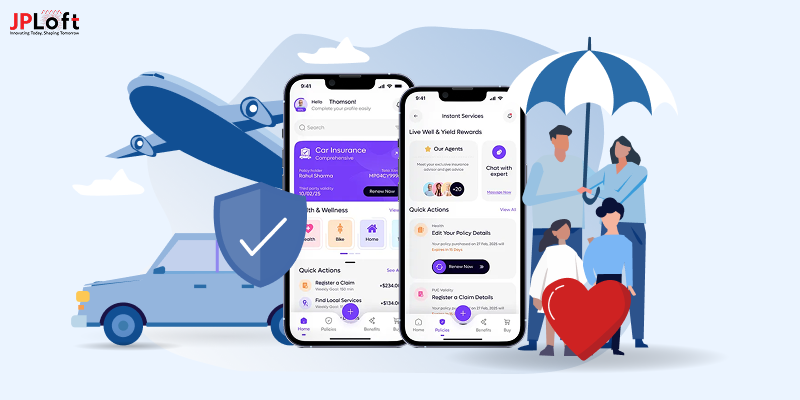Key Takeaways:
Building an insurance app requires a clear strategy, from defining features to selecting the right tech stack and ensuring security.
The insurtech market is booming, making 2025 the perfect time to develop an insurance app.
Essential features like policy management, AI chatbots, and fraud detection enhance user experience and trust.
AI is revolutionizing insurance apps by automating claims, personalizing services, and improving fraud prevention.
The cost to create an insurance app varies widely, depending on complexity, design, and region, ranging from $25,000 to $150,000+.
Overcoming challenges like compliance, data security, and maintenance ensures long-term app success and profitability.
Partnering with JPLoft gives businesses access to expert developers, cutting-edge technology, and complete support to build scalable, future-ready apps.
"The best way to predict the future is to create it." – Peter Drucker.
This quote perfectly reflects today’s insurance industry, where technology is shaping how services are delivered and experienced.
With customers demanding faster, more transparent, and accessible solutions, insurance apps are no longer optional; they’re essential.
From managing policies to filing claims, these apps simplify every step of the insurance journey.
So, how to develop an insurance app?
To build one, you need to define your target audience, choose the right features (like policy management, claims processing, and secure payments), design a user-friendly interface, and ensure compliance with data protection laws. Partnering with an experienced app development team is key to creating a secure, scalable, and future-ready solution.
This complete guide to create an insurtech app will walk you through everything from features and market insights to costs and monetization.
By the end, you’ll have a clear roadmap to create a future-ready insurance solution that meets evolving customer expectations in 2025 and beyond.
What is an Insurance App? A Beginner’s Overview
An insurance app is a digital solution designed to simplify the way customers interact with insurance providers. Instead of visiting physical offices or making multiple calls, users can now manage policies, pay premiums, compare plans, and file claims directly from their smartphones.
In simple terms, it’s a bridge between insurers and policyholders that ensures speed, convenience, and transparency.
Insurance apps cater to multiple domains such as life, health, auto, and property insurance.
For instance, a health insurance app can track medical claims and hospital networks, while an auto insurance app can help with roadside assistance or accident claims. This flexibility makes insurance apps a vital tool in today’s fast-paced digital-first world. Here’s about what an insurance app does.
1. Engaging User Experience
Building an insurance app isn’t just about digitizing paperwork, it’s about creating a seamless experience. Personalized dashboards, AI-driven recommendations, and real-time claim updates improve customer satisfaction and loyalty.
2. Focus on Security & Compliance
If you’re planning to create a mobile app for insurance services, you need to go beyond coding. Strong security features such as multi-factor authentication, encrypted databases, and compliance with laws like GDPR or HIPAA are essential.
3. A Strategic Business Investment
An insurance app isn’t just software; it’s a long-term strategy. From serving millennials who prefer self-service to helping businesses manage corporate insurance, these apps enhance trust and simplify processes in one place.
How Does an Insurance App Work? A Simple Breakdown
At its core, an insurance app acts as a digital platform connecting insurers with customers. It combines multiple services: policy management, premium payment, claims processing, and customer support into one easy-to-use application. But how exactly does it work? Let’s break it down.
1] User Onboarding & Profile Setup
Users start by signing up with personal details, KYC documents, and insurance preferences. This step is critical when you plan to create an insurance app, as smooth onboarding reduces drop-offs and builds trust.
2] Policy Management
Once registered, customers can explore available insurance products, compare plans, and purchase policies directly within the app. Companies that create an insurance app often integrate AI tools for personalized recommendations based on a user’s needs.
3] Payments & Renewals
Integrated payment gateways allow secure premium payments and automated renewal reminders. For startups, following guidelines to insurance app development ensures smooth payment flows with top-notch security.
4] Claims Submission & Tracking
Users can upload documents, photos, or accident details in real time. The app then processes these requests and provides claim status updates. This feature ensures transparency and helps build customer trust during critical moments.
5] Customer Support & Assistance
Chatbots, FAQs, and live chat options ensure users receive 24/7 support. Companies aiming to build an insurance app in simple steps should prioritize this feature to enhance customer experience.
Behind the scenes, insurers use the app’s backend system to manage policies, verify claims, analyze risks, and maintain compliance with regulations. For users, it feels seamless but for insurers, it’s a robust system powered by modern tech like AI, cloud storage, and advanced analytics.
So, if you’re considering how to develop an insurance app?, or even asking how to make an insurance app in 2025?, the key is to design an ecosystem where both customers and insurers benefit from speed, convenience, and transparency.
Insurance App Market Growth and Future Potential
The insurance app market is evolving rapidly, with digital-first solutions reshaping the industry. Here’s a breakdown of the key factors driving this growth:
1. Rising Market Value
-
According to industry reports, the global InsurTech market is projected to surpass $152.43 billion by 2030.
-
This growth highlights the immense potential for businesses planning to create an insurance app in 2025.
2. Changing Customer Behavior
-
Modern policyholders prefer mobile-based self-service over traditional paperwork.
-
A complete guide to create an insurtech app ensures faster policy management, instant claims, and real-time communication to match customer expectations.
3. Regional Market Leaders
-
North America and Europe dominate in adoption, while Asia-Pacific is catching up rapidly due to smartphone penetration.
-
Startups often collaborate with a mobile app development company in the UK to ensure regulatory compliance and create user-focused platforms.
4. AI and Automation as Growth Catalysts
-
Insurers are increasingly exploring how to create an insurtech app powered by AI.
-
Predictive analytics, chatbots, and automation help reduce costs while improving efficiency and scalability
5. Investor Confidence
-
Venture capital and investor funding in insurtech startups continue to grow.
-
Both entrepreneurs aiming to make an insurance app and established insurers must differentiate with innovative features like telematics, blockchain contracts, or health monitoring integrations.
6. Future Outlook
-
The guide to insurtech app development in 2025 emphasizes customer-first design, AI integration, and regulatory alignment.
-
Businesses embracing these trends are best positioned to capture market share in the rapidly growing digital insurance ecosystem.
Why Create an Insurance App? Key Business Benefits
Building an insurance app is no longer just a tech trend; it’s a necessity for insurers who want to stay competitive. Here are five powerful reasons why businesses should invest in insurance app development in 2025:
► Enhanced Customer Experience
Customers today expect fast, seamless, and digital-first services. By choosing to create an insurance app, insurers can offer policy management, claims filing, and premium payments in one place. This convenience improves satisfaction and loyalty.
► Streamlined Operations
When businesses develop an insurance app, they automate processes like underwriting, documentation, and claims verification. This reduces paperwork, eliminates errors, and helps insurers save time and costs. Partnering with the best mobile app development company ensures that these features are implemented effectively.
► Increased Market Reach
Insurance apps break geographical barriers by connecting insurers with users globally. With smartphone penetration rising, companies that follow guidelines to insurance app development can tap into diverse markets and attract digital-savvy customers.
► Innovation Through Technology
From AI-powered chatbots to telematics and IoT, insurers can integrate innovative solutions to meet evolving needs. Exploring unique insurance app ideas helps businesses stand out in a crowded market by offering features that competitors may lack.
► Data-Driven Insights
Modern apps collect valuable data on customer behavior, claims, and risks. Insurers who make an insurance app can analyze these insights to design better products, predict risks, and optimize decision-making.
In short, the decision to build an insurance app is about more than just going digital; it’s about creating a smarter, customer-centric business model that thrives in the future of insurtech.
Key Features to Include in an Insurance App in 2025
Creating a compelling insurance app requires more than just digitizing policies. The right features enhance usability, engagement, and trust. Here are the essential features to include when you create an Insurance app:
1. User-Friendly Dashboard
A clear and intuitive dashboard is crucial. Users should be able to view policies, claim status, payment history, and notifications at a glance. Focusing on mobile app design ensures that navigation is seamless, visually appealing, and easy to understand.
2. Policy Management
Allow users to purchase, renew, and manage their policies directly within the app. Offering features like policy comparison, reminders, and personalized recommendations is key when following a guide to develop an insurance app.
3. Secure Payments
Integrated payment gateways enable premium payments and renewals. Features like auto-renewal reminders, multiple payment options, and encryption for secure transactions help users trust your platform. Choosing the best payment gateway for your business ensures smoother transactions and enhanced customer confidence.
4. Claims Processing & Tracking
Users should be able to submit claims in real-time, upload documents, and track the approval process. Successful solutions that build an insurance app in simple steps focus on creating smooth and transparent claims workflows, ensuring a better customer experience.
5. AI-Powered Assistance
Chatbots and virtual assistants provide 24/7 support, answer FAQs, and guide users through policy selection or claim submissions. Incorporating AI ensures the app is intelligent and responsive, aligning with modern steps to build an insurtech app effectively.
6. Notifications & Alerts
Push notifications and alerts keep users informed about policy renewals, claim status, discounts, and new offerings. Timely updates help maintain engagement and reduce churn.
7. Data Analytics & Insights
Collecting and analyzing user data allows insurers to offer personalized policies and risk management insights. A well-designed analytics module aligns with the insurance app development guide and helps businesses optimize services.
By including these features, businesses not only make an insurance app but also create a powerful digital tool that improves customer engagement, simplifies operations, and strengthens trust in the insurance ecosystem.
Step-by-Step Guide to Develop an Insurance App
Building an insurance app requires a structured approach to ensure functionality, compliance, and user-friendliness. Below is a step-by-step process that will help you create a robust insurance app in 2025.
Step 1: Define Your App’s Purpose & Target Audience
Before writing a single line of code, businesses need to understand what problem their app will solve and for whom. Clear objectives and a defined audience help streamline development.
A) Conduct Market Research
Explore the latest insurance app trends and study what successful apps like Lemonade, Root, or Policybazaar are doing right. Market analysis reveals gaps and opportunities for innovation.
B) Identify Your Target Users
Determine whether your app is aimed at individuals seeking quick policy access, agents managing portfolios, or enterprises requiring bulk policy handling. Each group has different expectations.
C) Define Core Objectives
Decide if your app will focus on policy management, claim processing, or insurance comparison. A well-defined scope ensures you don’t overspend on unnecessary features.
D) Validate Your Idea
Conduct surveys, interviews, or MVP (Minimum Viable Product) testing to validate your app idea. This step reduces risks before investing heavily in full-scale development.
Step 2: Choose the Right Features for the Insurance App
The success of your app depends on its features. Striking the right balance between must-have and advanced features ensures user satisfaction.
A) Essential Features
Include basics like user registration, policy browsing, premium calculator, and claims submission. These are the backbone of any insurance mobile app.
B) Advanced Features
Modern users expect AI-driven chatbots, voice assistants, and personalized policy recommendations. Adding such features gives your app a competitive edge.
C) Security Features
Insurance apps deal with sensitive data, so features like multi-factor authentication, biometric login, and data encryption are non-negotiable.
D) Integration Features
Enable smooth connections with payment gateways, government ID verification systems, and insurance company APIs for seamless policy access and claims.
Step 3: Select the Right Tech Stack
Choosing the right mobile app tech stack determines your app’s scalability, performance, and security.
A) Frontend Development
Use frameworks like React Native or Flutter to ensure a seamless, cross-platform experience for both Android and iOS users.
B) Backend Development
Opt for robust technologies like Node.js, Django, or Spring Boot that can handle large volumes of user and policy data securely.
C) Database Management
Databases such as PostgreSQL or MongoDB ensure fast retrieval of policy records and claims history.
D) APIs and Integrations
Third-party APIs for payments, insurance policy verification, and fraud detection make the app more functional and trustworthy.
Step 4: Build the Right Development Team
Success depends on having the right talent in place. It’s essential to hire dedicated developers with proven expertise in creating secure, scalable, and feature-rich insurance apps to bring your project to life.
A) Project Manager
Oversees the project timeline, communicates with stakeholders, and ensures the app stays aligned with business goals.
B) UI/UX Designers
Design intuitive interfaces, ensuring the UI/UX of the app is user-friendly and makes complex insurance processes simple.
C) Developers
Frontend and backend developers bring the app to life using the selected tech stack and coding best practices.
D) QA Testers
A dedicated QA team performs continuous testing to eliminate bugs, enhance performance, and ensure compliance with industry standards.
Step 5: Develop & Test the MVP
A Minimum Viable Product (MVP) lets you launch faster, gather feedback, and make improvements before scaling.
A) MVP Development
Focus only on core features like user registration, policy search, and premium payment in the initial release.
B) User Testing
Launch beta testing to gather feedback from real users and identify areas of improvement. This ensures the final version is error-free.
C) Iterative Updates
Incorporate user feedback into subsequent updates, ensuring the app evolves with user expectations.
D) Cost Efficiency
MVP development minimizes upfront investment while allowing you to test real market demand.
Step 6: Ensure Compliance & Security
Since insurance apps deal with sensitive financial and personal data, compliance and security are critical.
A) Data Compliance
Ensure your app follows regulations such as GDPR, HIPAA, or local insurance laws depending on your target market.
B) Encryption Standards
Use SSL certificates, AES encryption, and other modern protocols to safeguard data.
C) Fraud Detection
Integrate AI-driven fraud detection systems to identify suspicious activity in claims or payments.
D) Regular Security Audits
Conduct periodic audits and penetration testing to keep the app secure against evolving cyber threats.
Step 7: Launch & Post-Launch Support
The final step is to make your app available to users and ensure its long-term success through continuous improvements.
A) App Store Optimization
Optimize your app’s title, description, and visuals for Google Play and App Store to increase visibility.
B) Marketing Strategy
Leverage digital marketing campaigns, partnerships with insurers, and targeted ads to attract your audience.
C) Continuous Updates
Regular updates improve performance, fix bugs, and keep the app aligned with evolving technologies.
D) Ongoing Maintenance
Ongoing updates, bug fixes, and performance monitoring are essential to keep your app running smoothly. Partnering with a reliable team ensures long-term stability, security, and user satisfaction.
Use of AI in Building an Insurance App: Smarter Solutions in 2025
Artificial Intelligence has become a game-changer in InsurTech, transforming how businesses create an insurance app and deliver services. If you are exploring the guide to build an insurance app, integrating AI is no longer optional; it’s essential.
A] AI-Powered Chatbots & Virtual Assistants
AI-driven chatbots provide 24/7 support, guiding users through policy selection, claims, and FAQs. This helps businesses make an insurance app more interactive, customer-friendly, and efficient.
B] Personalized Policy Recommendations
By analyzing user data and behavior, AI tailors policy suggestions. Whether it’s health, auto, or life insurance, AI ensures customers receive options that best fit their profile aligning with the insurance app development guide.
C] Fraud Detection & Risk Management
AI algorithms analyze unusual activities and detect fraudulent claims in real-time. For companies aiming to create an Insurance app, this feature improves security while reducing operational losses.
D] Automated Claims Processing
Instead of days or weeks, AI reduces claim approval to hours. Optical Character Recognition (OCR) and machine learning streamline document verification, making the claims process smoother. This feature is vital in the steps to build an Insurtech app effectively.
E] Predictive Analytics for Better Decision-Making
AI predicts customer needs, future risks, and market shifts. Businesses that develop an insurance app in 2025 can leverage predictive insights to stay competitive and enhance customer retention.
F] Voice & Image Recognition
Advanced AI technologies such as voice recognition (for customer queries) and image recognition (for claim verification) make apps smarter and user-centric. This not only enhances user trust but also streamlines complex processes.
If you’re planning to embrace these innovations, it’s time to create an AI app that blends seamlessly with insurance workflows and offers a future-ready customer experience. Partnering with experts who provide professional AI app development services ensures your insurance solution is scalable, intelligent, and future-proof.
By leveraging AI, insurers don’t just build an insurance app; they create a smart, adaptive ecosystem. AI ensures efficiency, security, personalization, and above all, customer satisfaction, which is the cornerstone of successful guide to insurtech app development in 2025.
Top Insurance Apps in 2025 You Should Know About
When exploring the insurance app development guide, it’s important to learn from existing success stories. By reviewing the most popular apps, you can understand what makes them stand out and apply those insights as you create an insurance app in 2025.
1. Lemonade
A pioneer in InsurTech, Lemonade uses AI and behavioral economics to provide fast, transparent insurance. Their AI-powered claims process is so efficient that many claims are settled instantly. This is a great example if you want to make an insurance app that is customer-first.
2. Allstate Mobile
Allstate’s app provides policy management, roadside assistance, and Drivewise, a feature that rewards safe driving. It’s an excellent case study for those following a guide to build an insurance app with added value services.
3. GEICO Mobile
GEICO is known for its user-friendly dashboard, digital ID cards, and 24/7 virtual assistance. It highlights how to make an insurance app? in simple steps while ensuring top-notch customer engagement.
4. Progressive
With personalized policy suggestions and Snapshot (a usage-based insurance program), Progressive demonstrates how insurers can use AI and data analytics to boost customer trust. It’s a prime example for anyone asking, “How to create an insurtech app?”
5. Prudential Pulse
Prudential combines insurance with health tracking, wellness advice, and AI-driven insights. For those researching how to develop an Insurtech app?, this app shows how merging healthcare and insurance creates stronger user engagement.
6. State Farm
With seamless claims management, roadside help, and payment solutions, State Farm illustrates how insurers can create an insurance app that balances simplicity and advanced features.
Learning from these apps not only provides inspiration but also helps you refine your own stages to create an insurance app in 2025. Partnering with experts like a mobile app development company Denver can give your project the competitive edge needed to succeed in this growing market.
How Much Does It Cost to Create an Insurance App in 2025?
One of the most common questions asked by startups and enterprises is: “How much does it cost to create an Insurance app?” On average, the cost ranges from $25,000 to $150,000+, depending on features, complexity, design, and the development region. A well-structured insurance app development guide helps you understand the cost ranges and where to invest wisely.
Quick Snapshot: Factors Impacting Cost
|
Cost Factor |
Impact on Budget |
|
Features & Functionality |
Basic features cost less; advanced AI-driven features increase expenses. |
|
UI/UX Design |
Simple UI is cheaper; custom, animated, and user-focused designs cost more. |
|
Technology Stack |
Modern, scalable tech raises costs but ensures future readiness. |
|
Development Team |
Hiring freelancers is cheaper; professional teams ensure quality but cost more. |
|
Region of Development |
Region of Development |
1. Features & Functionality
Basic features like policy management, claims filing, and payment gateways cost less. Advanced features like AI-driven chatbots, predictive analytics, and fraud detection increase the overall budget. If you want to develop an insurance app in 2025 with smart features, you should plan for higher investment.
2. UI/UX Design
The user interface (UI) and user experience (UX) play a major role in costs. A simple interface is budget-friendly, but a visually appealing, intuitive app interface with animations and custom elements will cost more.
3. Technology Stack
The chosen tech stack, including programming languages, frameworks, and APIs, significantly influences expenses. Opting for modern, scalable technologies can make your app future-ready, but it adds to the development bill.
4. Development Team
The size and expertise of your team also matter. Businesses often choose to hire a team of professionals or partner with an experienced firm to ensure quality. This step is crucial when following the guide to build an insurance app.
5. Region of Development
Rates vary across geographies. Developers in the US and UK charge higher compared to Asia or Eastern Europe. Partnering with the right team balances cost and quality.
Estimated Cost Breakdown
Here’s a rough estimate of how much it may cost to build an insurance app in 2025:
|
App Complexity |
Estimated Cost Range |
Timeline |
|
Basic Insurance App |
$25,000 – $40,000 |
3–4 months |
|
Medium Complexity App |
$40,000 – $80,000 |
4–6 months |
|
Advanced Insurance App |
$80,000 – $150,000+ |
6–9 months or longer |
These figures are approximate and vary depending on custom requirements, integrations, and updates.
Is It Worth the Investment?
Yes. When you make an insurance app that includes modern features, AI, and secure systems, the ROI is significant. Think long-term maintenance, upgrades, and new feature rollouts are also part of the budget. Partnering with experts can help you optimize mobile app development cost without compromising quality.
Ultimately, the exact cost to create an insurance app will depend on your business goals, features, and chosen development partner. With careful planning and the right approach, you can turn your vision into a profitable InsurTech solution.
How Does an InsurTech App Make Money in 2025?
Building a great product is one thing, but ensuring it generates sustainable revenue is another. If you’re following a guide to develop an insurance app, it’s crucial to understand the revenue models available for InsurTech solutions.
Here are the most effective monetization strategies to consider when you create an Insurance app in 2025.
1. Commission-Based Model
One of the most common methods is charging a commission on every policy sold or renewed through the app. For example, when a user buys auto or health insurance, the insurer pays a percentage to the platform. This strategy is simple to adopt if you make an insurance app targeting multiple insurers.
2. Subscription Plans
Some apps offer premium subscriptions that unlock additional features like advanced analytics, priority support, or exclusive policy offers. This is an excellent model for apps that build an insurance app in simple steps, yet want to provide layered value over time.
3. Freemium Approach
The freemium model gives users basic features for free while charging for advanced services such as fraud detection, instant claims, or financial planning tools. Many startups adopt this model when experimenting with different app ideas, as it allows quick user acquisition.
4. Advertisements & Partnerships
Partnerships with healthcare providers, auto repair shops, or financial service companies can open revenue streams through cross-selling and targeted ads. For instance, an app can recommend a trusted garage during claim processing, generating partner-based income.
5. Data Insights & Analytics
In 2025, data is the new currency. Insurers are willing to pay for anonymized, aggregated insights that help them understand customer behavior, risks, and preferences. If you’re looking at the stages to create an insurance app in 2025, monetizing analytics should definitely be part of your strategy.
6. Value-Added Services
Many modern apps integrate financial advisory, wellness programs, and investment tools. These services not only enhance customer engagement but also add new revenue streams. If you follow a guide to build an insurance app, including value-added services gives you an edge over competitors.
Ultimately, the monetization model depends on your app’s vision, target market, and feature set. The best approach often combines two or more strategies to ensure steady income while keeping users engaged.
Key Challenges in Building an Insurance App in 2025
While many companies are eager to develop an insurance app in 2025, the journey is not without obstacles. From compliance issues to user trust, insurers must navigate multiple challenges to ensure success. Here are the most critical hurdles to consider when you plan to create an Insurance app or follow a guide to build an insurance app.
Challenge 1: Regulatory Compliance
Insurance is one of the most highly regulated industries. Each region has unique laws around data storage, claims, and underwriting. When you make an insurance app, ensuring compliance with HIPAA, GDPR, or other standards is mandatory. Failing to do so can result in hefty fines and reputational damage.
Challenge 2: Data Security & Privacy
Since insurance apps handle sensitive personal and financial data, cybersecurity is a top concern. A proper insurance app development guide emphasizes robust encryption, two-factor authentication, and fraud detection systems to maintain user trust.
Challenge 3: Integration with Legacy Systems
Many insurance companies still rely on old IT infrastructure. Integrating new apps with these legacy systems can be time-consuming and expensive. This becomes a major bottleneck for firms trying to build an insurance app in simple steps without disrupting existing workflows.
Challenge 4: User Experience & Design
Even with the best features, poor UX can drive users away. Creating a seamless, intuitive design is essential when you create an insurance app. In 2025, customers expect real-time responses, easy navigation, and engaging interfaces that simplify policy management and claims.
Challenge 5: Post-Launch Maintenance
Launching is just the beginning. Continuous updates, bug fixes, and upgrades are critical to keeping the app relevant. Many businesses struggle to allocate resources for long-term upkeep. Partnering with experts in mobile app maintenance services can help insurers manage this challenge effectively.
Challenge 6: Building Trust with Users
Insurance is built on trust. Users may hesitate to adopt a digital platform if they are unsure about transparency, claim approval speed, or data handling practices. For businesses looking at the stages to create an insurance app in 2025, trust-building features like AI-powered claims, instant notifications, and secure payments are essential.
Challenge 7: High Development Costs
Creating a feature-rich app with AI, analytics, and advanced integrations requires significant investment. While the guide to develop an insurance app helps optimize costs, balancing innovation with budget remains a challenge.
Overcoming these obstacles requires a clear roadmap, advanced technology adoption, and reliable development partners. By addressing these issues early, businesses can successfully make an insurance app that is not only functional but also future-ready.
Partner with JPLoft to Develop Your Insurance App in 2025
Turning your insurance app vision into reality requires expertise, precision, and a trusted development partner. With years of experience, JPLoft helps businesses build an insurance app in simple steps, guiding them from concept to deployment.
Our team specializes in integrating AI, secure payment systems, and advanced features that ensure your app meets modern user expectations. By partnering with JPLoft, you gain access to cutting-edge technology, dedicated developers, and end-to-end support, making it easier to deliver a competitive and reliable InsurTech solution.
For a seamless, future-ready app, collaborate with JPLoft, the leading insurance app development company, and bring your vision to life.
Conclusion
Developing an insurance app in 2025 is more than just digitizing policies, it’s about creating a seamless, secure, and engaging platform for users. By understanding the steps to build an insurance app, integrating AI for smarter operations, and learning from top-performing apps, businesses can deliver solutions that meet modern expectations.
While challenges like compliance, security, and maintenance exist, careful planning and expert guidance can turn these obstacles into opportunities. Following this guide to develop an insurance app ensures your product is future-ready, efficient, and positioned to succeed in the competitive InsurTech market.
FAQs
An insurance app is a digital platform that allows users to browse policies, manage their accounts, submit claims, and make payments directly from their smartphones. It simplifies insurance processes for both customers and providers.
To develop an insurance app, start by defining your target audience, identifying core features, selecting the right tech stack, and building a team of experienced developers. Incorporating AI, security measures, and smooth integrations ensures a robust and user-friendly app.
Key features include policy management, claims submission, payment gateways, AI chatbots, real-time notifications, personalized recommendations, and data security mechanisms.
The timeline depends on complexity. A basic app may take 3–4 months, a medium-complexity app 4–6 months, and an advanced app with AI features can take 6–9 months or more.
Costs vary based on features, design, tech stack, and development region. Basic apps can cost $25,000–$40,000, medium-complexity apps $40,000–$80,000, and advanced apps $80,000–$150,000+.
Yes. AI enhances customer service with chatbots, automates claims processing, detects fraud, predicts user needs, and offers personalized recommendations, making the app more efficient and engaging.













Share this blog